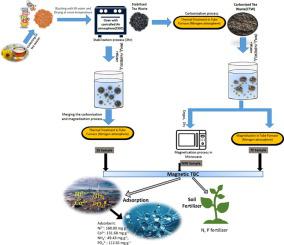Journal of Advanced Research ( IF 11.4 ) Pub Date : 2021-08-05 , DOI: 10.1016/j.jare.2021.08.001 Kamyar Shirvanimoghaddam 1 , Bożena Czech 2 , Katarzyna Tyszczuk-Rotko 3 , Magdalena Kończak 4 , Seyed Mousa Fakhrhoseini 1 , Ram Yadav 1 , Minoo Naebe 1

|
Introduction
Biochar utilization for adsorption seems to be the most cost-effective, easy/fast approach for pollutants removal from water and wastewater. Due to the high adsorption properties, magnetic biochar proved to be efficient in the sorption of heavy metals and nutrients. Although there are several studies on development of magnetic biochars, there is a lack of research on development of high-performance magnetic biochar from food waste for removal applications.
Objectives
This study aimed at preparing new classes of magnetic biochar derived from tea waste (TBC) for removal of heavy metals (Ni2+, Co2+), and nutrients (NH4+ and PO43−) from water and effective fertilizer (source of NH4+ and PO43−).
Methods
Standard carbonization process and ultrafast microwave have been used for fabrication of TBCs. The removal of nickel, cobalt as the representatives of heavy metals, and over-enriched nutrients (NH4+ and PO43−) from water were tested and the removal kinetics, mechanism, and the effect of pH, dissolved organic matter and ionic strength were studied. Simultaneously, possible fertilizing effect of TBC for controlled release of nutrients (NH4+ and PO43−) in soil was investigated.
Results
Up to 147.84 mg g−1 of Ni2+ and 160.00 mg g−1 of Co2+ were adsorbed onto tested biochars. The process of co-adsorption was also efficient (at least 131.68 mg g−1 of Co2+ and 160.00 mg g−1 of Ni2+). The highest adsorbed amount of NH4+ was 49.43 mg g−1, and the highest amount of PO43− was 112.61 mg g−1. The increase of the solution ionic strength and the presence of natural organic matter affected both the amount of adsorbed Ni2++Co2+ and the reaction mechanism.
Conclusions
The results revealed that magnetic nanoparticle impregnated onto tea biochar, can be a very promising alternative for wastewater treatment especially considering removal of heavy metals and nutrients and slow-release fertilizer to improve the composition of soil elements.
中文翻译:

从茶叶废料中可持续合成玫瑰花状磁性生物炭用于环境应用
介绍
用于吸附的生物炭利用似乎是从水和废水中去除污染物的最具成本效益、简单/快速的方法。由于高吸附性能,磁性生物炭被证明在吸附重金属和营养物质方面是有效的。尽管有几项关于磁性生物炭开发的研究,但缺乏从食物垃圾中开发用于去除应用的高性能磁性生物炭的研究。
目标
本研究旨在从茶叶废料(TBC)中制备新型磁性生物炭,用于去除水中重金属(Ni 2+、Co 2+)和营养物质(NH 4 +和 PO 4 3−)和有效肥料( NH 4 +和 PO 4 3-的来源)。
方法
标准碳化工艺和超快微波已用于制造 TBC。测试了以镍、钴为代表的重金属以及过度富集的营养物质(NH 4 +和PO 4 3-)从水中去除的动力学、机理以及pH、溶解有机物和离子的影响。强度进行了研究。同时,研究了TBC对土壤中养分(NH 4 +和PO 4 3-)控制释放的可能施肥效果。
结果
高达 147.84 mg g -1的 Ni 2+和 160.00 mg g -1的 Co 2+被吸附到测试的生物炭上。共吸附过程也是有效的(至少 131.68 mg g -1的 Co 2+和 160.00 mg g -1的 Ni 2+)。NH 4 +的最高吸附量为49.43 mg g -1,PO 4 3-的最高吸附量为112.61 mg g -1。溶液离子强度的增加和天然有机物的存在对Ni 2+ +Co 2+的吸附量都有影响。和反应机理。
结论
结果表明,浸渍在茶生物炭上的磁性纳米颗粒可以成为一种非常有前景的废水处理替代方案,特别是考虑到去除重金属和养分以及缓释肥料以改善土壤元素的组成。











































 京公网安备 11010802027423号
京公网安备 11010802027423号